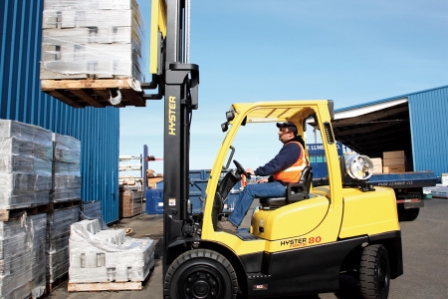
Recent improvements can reduce overall lift truck expenses and boost productivity
Metal construction often requires material handling equipment to support effective operations. Whether using the lift truck at a warehouse or preparation facility or on a job site, metal construction contractors can take advantage of new and improved lift truck technologies. These improvements, in areas such as powertrain technology, hydraulic systems, tire protection, metal-handling attachments and visibility systems, can reduce overall lift truck expenses and boost productivity, leading to a stronger bottom line.
Vision systems
Operating lift trucks carrying large loads can cause critical point visibility to be reduced. Limited visibility can lead to damage of the product, lift truck or facility because the truck could run into obstacles that may be invisible to the operator. A camera system with display in the operator compartment can alleviate the problem and offer multiple critical viewpoints to the operator. These cameras can be mounted on the truck front, side and rear to offer all-around visibility improvements.
Powertrain and hydraulic system
When it comes to lift truck engines, bigger is not always better, especially when attempting to reduce fuel consumption and overall operating costs. Right-sized or smaller displacement engines match the demand of the loads carried while not losing productivity. Many lift trucks utilized large engines to simultaneously power the maximum demands of the hydraulic system and the powertrain, but new load management systems are able to distribute power to where it is most needed based on the driver’s input.
These new systems enable the use of smaller and more efficient engines, reducing fuel costs and emission levels while delivering lower maintenance costs and quieter operation. On-demand cooling allows the cooling fan to draw power only when cooling is required. Traditional direct drive fans draw high levels of power at all times. This feature reduces accessory loads on the powertrain, consumes less fuel and lowers noise levels.
 |
Throttle-up features on lift trucks can provide an automatic response to lift inputs from the operator when the lift lever is activated. The driver’s input for hydraulic power automatically increases the engine speed to the efficient sweet spot, delivering improved fuel economy.
Engine idle time estimates range from 20 to 40 percent as the operator waits or has left the lift truck compartment. Empty seat engine shutdown technologies reduce fuel consumption by shutting down the truck when the operator is out of the seat for extended periods of time, limiting idle hours and decreasing the frequency of regular maintenance intervals. Hibernate idle features automatically reduce the idle speed when no demand is placed on the engine. These hibernate features can deliver 20 to 30 percent less fuel consumption during idle times.
Another productivity and performance feature on many modern lift trucks is selectable operating modes. This feature allows the operations manager to choose a high-performance mode to maximize engine output or an economy mode to minimize fuel consumption, depending on the needs of the operation. Newer transmission designs also include additional gears to allow operation at lower engine speeds and protection systems that help prevent damage. These systems can either reduce performance or shut down the engine if parameters are out of a normal specified range.
A final technology to consider is on-demand, load-sensing hydraulics. This technology delivers hydraulic oil flow only when required, unlike fixeddisplacement (gear pump) systems, which are continuously pumping oil regardless of whether it is needed. A variable displacement pump, capable of more oil displacement even at low engine speeds, allows the engine to run at a lower rpm, extending the life of components and operating more quietly. On-demand hydraulic systems typically consume as much as 10 percent less fuel than a fixed displacement hydraulic system. Additionally, with less oil flowing, the oil and filters last longer and hoses, seals and components wear less as the system produces less heat than fixed displacement systems.
Tire-saving technologies
Next to the operator and fuel consumption, tires are often the next largest lift truck operating cost. Moving metal construction supplies can be extremely harsh on lift truck tires. Poor ground conditions and potentially sharp debris (metal strapping, scrap pieces) in the lift truck’s driving path can cause tire damage or failure. A tire shield, originally developed for military applications, can help reduce tire side-wall damage. The shields are mounted on the rim of the tire, forming an obstacle to objects the tire could encounter.
Putting it all together
By employing some or all of these features and technologies, metal construction operations will see cost savings in their lift truck fleet. With vision systems, tire protection devices or engine system technologies, estimated operational cost savings are up to 50 percent. That kind of savings will give a lift to any bottom line.
Herman Klaus is the big truck product manager at Hyster Co., Greenville, N.C. To learn more, visit www.hyster.com.






